1 动词之感官动词与使役动词
感官动词(1)

first 感官动词1. 感官动词是表示人的感官动作,常见的有see/notice/look/watch/listen to/hear/feel/taste/smell/sound 等。
2. 感官动词的用法(1) 感官动词+宾语+V 表示经历事件的完整过程感官动词+宾语+Ving 表示动作正在进行,经历事件的部分过程感官动词+宾语+Ved 表示宾语与do 是被动关系I saw him work in the garden yesterday.昨天我看见他在花园里干活了。
(强调"我看见了"这个事实)I saw him working in the garden yesterday.昨天我见他正在花园里干活。
(强调"我见他正干活"这个动作)The managers discussed the plan that they would like to see carried out the next year.注意:若不定式作感官动词的补足语,用于被动语态,后面原有动词原形改为带to 不定式We saw him go into the restaurant. → He was seen to go into the restaurant.I hear the boy cry every day. → The boy is heard to cry every day.(2)look, sound, smell, taste, feel 可当系动词,后接形容词。
He looks angry. It sounds good. The flowers smell beautiful. The sweets taste sweet. The silk feels soft.I felt tired. They all looked tired.这些动词都不用于被动语态。
动词的分类-教师版讲解
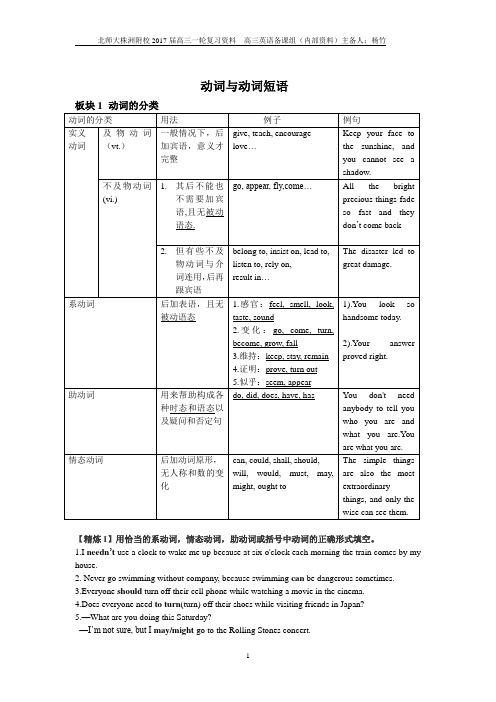
动词与动词短语板块1动词的分类【精炼I】用恰当的系动词,情态动词,助动词或括号中动词的正确形式填空。
1.I needn’t use a clock to wake me up because at six o'clock each morning the train comes by my house.2. Never go swimming without company, because swimming can be dangerous sometimes.3.Everyone should turn off their cell phone while watching a movie in the cinema.4.Does everyone need to turn(turn) off their shoes while visiting friends in Japan?5.—What are you doing this Saturday?—I’m not sure, but I may/might go to the Rolling Stones concert.6.The poor boy went blind at the age of three.7.This shirt looks as if it is made of cotton.8.The moment Mr Zhang went to bed, he fell asleep9.Their plan turned t o be a perfect one.10. His wish to become a driver has come true.11.In the past 30 years China has made(make)great advances in the socialist revolution and socialist construction.12..He said that he dropped his bag when he was running (run) for the bus.13. The twins, who had finished (finish) their homework, were allowed to play badminton on the playground.14. The giant panda is loved (love) by people throughout the world.15. More expressways will be built(build) in Sichuan soon to promote the local economy.【精炼II】在空格处填入适当的词,使句意完整准确。
“感使动词+宾语+宾语补足语”结构中“宾语补足语”的用法
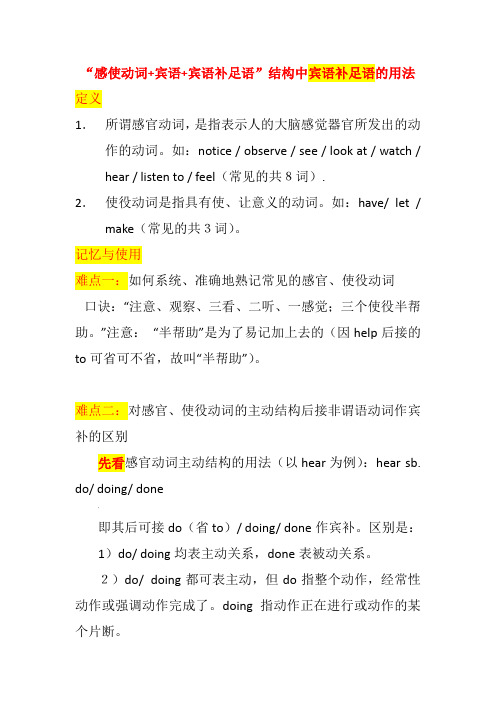
“感使动词+宾语+宾语补足语”结构中宾语补足语的用法定义1.所谓感官动词,是指表示人的大脑感觉器官所发出的动作的动词。
如:notice / observe / see / look at / watch / hear / listen to / feel(常见的共8词).2.使役动词是指具有使、让意义的动词。
如:have/ let / make(常见的共3词)。
记忆与使用难点一:如何系统、准确地熟记常见的感官、使役动词口诀:“注意、观察、三看、二听、一感觉;三个使役半帮助。
”注意:“半帮助”是为了易记加上去的(因help后接的to可省可不省,故叫“半帮助”)。
难点二:对感官、使役动词的主动结构后接非谓语动词作宾补的区别先看感官动词主动结构的用法(以hear为例):hear sb. do/ doing/ done'即其后可接do(省to)/ doing/ done作宾补。
区别是:1)do/ doing均表主动关系,done表被动关系。
2)do/ doing都可表主动,但do指整个动作,经常性动作或强调动作完成了。
doing指动作正在进行或动作的某个片断。
3)done指某事由别人做(被做),也作“遭受”解。
试比较:A)I heared him sing a song. 我听他唱了一首歌(指自始至终整个过程)。
B)I heared him singing a song. 我听见他正在唱歌唱(指当时动作的某个片断)。
C)I heared a song sung.我听见(有人)唱歌(逻辑主语“歌”与“唱”是被动关系。
)再看使役动词主动结构的用法:have sb. do/ doing/ done, make/let sb. do/ donehave后也接do(省to)/ doing/ done作宾补,区别是:1)do/ doing 均表主动关系,done表被动关系。
2)do/ doing虽然都表主动,但do指目前和将来或经常性、反复性的动作。
第八次课 动词之感官动词 和使役动词

动词之感官动词和使役动词:中高考失分难点第一,什么是感官动词:1,听:listen to, hear2,视:look at, watch, see3,嗅:smell,4,触:feel find5,味:taste感官动词的特殊的用法:如何正确使用?用法一:E.g. Tom drove his car away. 这个过程我们来分析一下:I see him drive away his car(see sb do表示此动词被你彻彻底底看见,看到动作的全过程,强调结果)用法二:E.g. I see him wait for the bus (看到的只是一个片段,我们see sb doing,表示看到某人正在做什么)I saw him waiting for the bus练习翻译句子:I didn’t hear you come inI suddenly felt something touch me on the shoulder.I could hear it rainingListen to the birds singing!Can you smell something burning?I found Sue in my room reading my letters.第二:我们来判断全程还是片段?Did anybody see the accident (happen/ happening?) We listen to the old man (tell/ telling) his story from beginning to end.Listen! Can you hear a baby (cry/ crying?)Why did you turn around suddenly?I hear someone (call/ calling) my name.We watched the two men (open/ opening) a window and (climb/ climbing) through it into the house. When we got home, we found our cat (sleep/ sleeping) on the table.第三:感官动词的反着说,即被动语态,感官动词的被动语态1, I saw the girl come in(全程)the girl was seen to come inSee sb do —— be seen to doEg. 练习: I saw him fall2, I saw the girl dancingThe girl was seen dancingSee sb doing ___ be seen doing3,练习:1, he looked around and caught a man___ his hand into the pocket of a passenger.A, put B, to be putting C, to put D, putting2, People often see him___ basketball on the playground.A, play B, playing C, to play D, played3, the girl is heard___ the piano in the next room on Sundays.A, plays B, to play C, played D, play第四,使役动词(让你做某事,不停折磨你,奴役的感觉)1,make sb do2,have sb do3,get sb do1,make的用法:Make sb do 让某人做某事He made his son clean the room every day.Make sb/ sth+ adj 使…某人某物Have I made myself clear?Make sb. Sth=make sth for sbMy uncle will make me a kite2,have的用法Have sb do sth 让某人去做某事He had his son clean the room every dayHave sb doing sth 让某人持续做某事He has us laughing all through the lunchHave sth done 某事让别人去做He has the car washed every week(have sth done同上)E.g. Jill had the roof repaired yesterday(翻译)提示:让某事被别人做Have object+ past participate 翻译练习:1,Where did you have your hair cut?2,Julia has just had central heating installed inher house3,We are having the house painted at the moment. 4,How often do you have your car serviced?5,I think you should have that coat cleaned soon. 6,I don’t like having my photograph taken练习:我剪头发他们在拍照 they have一位女士自己擦鞋 wipe shoes一位男士让别人在擦鞋4,get 的用法:get sb to do sth让某人做某事he got his son to clean his room every dayget sb/ sth doing造句练习get sth done让某事被做造句练习使役动词的被动语态:make sb do___ be made to dohave sb do___ be made to do ( have his son clean room= his son was made to clean)练习:1, His mom made___ yesterday to celebrate his birthdayA, a cake to him B, a cake himC, a cake for him D,a cake at him2, What are you going to do tomorrow?I am going to have my bike___A, repairs B, to repairC, repaired D, repairing3, the woman got her daughter_D__ the clothes by herselfA, washed B, washC, washing D, to wash总结:感官 sb do_ to doSb doing_ doing使役make sb dohave sb do to doget sb do练习:1,the heavy snow made the mountain climbers___ on their way to home.A, stop B, to stopC, stopping D, stopped2,3,the girl was heard ___the piano in the next room A, play B playsC, played D, to playSee sb do= sb was seen to doHear sb do = sb was heard to doSee sb doing= sb was seen doingHear sb doing=sb was heard doingI hear the girl playing the piano 。
动词种类及用法总结
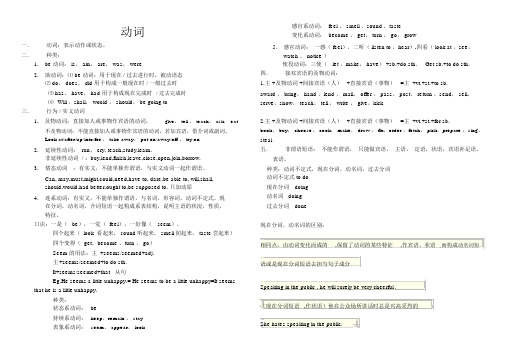
动词一.动词:表示动作或状态。
二.种类:1.be 动词: is, am, are, was, were2.助动词:⑴ be 动词:用于现在 / 过去进行时,被动语态⑵ do, does, did 用于构成一般现在时 / 一般过去时⑶ has, have, had 用于构成现在完成时/ 过去完成时⑷Will ,shall, would , should, be going to三.行为 / 实义动词1. 及物动词:直接加人或事物作宾语的动词。
give, tell , teach, ask, eat不及物动词:不能直接加人或事物作宾语的动词,若加宾语,借介词或副词。
Look at/after/up/into/for , take away, put on/away/off , try on.2.延续性动词: run, cry, teach,study,learn.非延续性动词 / :buy,lend,finish,leave,close,open,join,borrow.3.情态动词:有实义,不能单独作谓语,与实义动词一起作谓语。
Can, may,must,might,could,need,have to, dare,be able to, will,shall,should,would,had better,ought to,be supposed to. 只加动原4.连系动词:有实义,不能单独作谓语,与名词,形容词,动词不定式,现在分词,动名词,介词短语一起构成系表结构,说明主语的状况,性质,特征。
口诀:一是(be),一觉( feel),一好像(seem)。
四个起来( look 看起来, sound 听起来, smell 闻起来, taste 尝起来)四个变得( get,become ,turn , go)Seem 的用法:主 +seems/seemed+adj.主+seems/seemed+to do sth.It+seems/seemed+that从句Eg.He seems a little unhappy.= He seems to be a little unhappy=It seems that he is a liitle unhappy.种类:状态系动词:be持续系动词:keep,remain , stay表象系动词:seem, appear, look感官系动词: feel , smell ,sound ,taste变化系动词: become , get, turn , go, grow5.感官动词:一感( feel),二听( listen to ,hear),四看( look at ,see,watch , notice )使役动词:三使(let ,make, have) +sb.+do sth.Get sb.+to do sth.四.接双宾语的及物动词:1.主 +及物动词 +间接宾语(人)+直接宾语(事物)=主 +vt.+st.+to sb.award , bring, hand ,lend , mail, offer , pass, post, return ,send, sell,serve,show, teach, tell , write , give,kick2.主 +及物动词 +间接宾语(人)+直接宾语(事物)=主 +vt.+st.+for sb.book, buy, choose, cook, make, draw , fix,order ,fetch, pick,prepare ,sing,steal五.非谓语短语:不能作谓语,只能做宾语,主语,定语,状语,宾语补足语,表语。
使役动词与感官动词
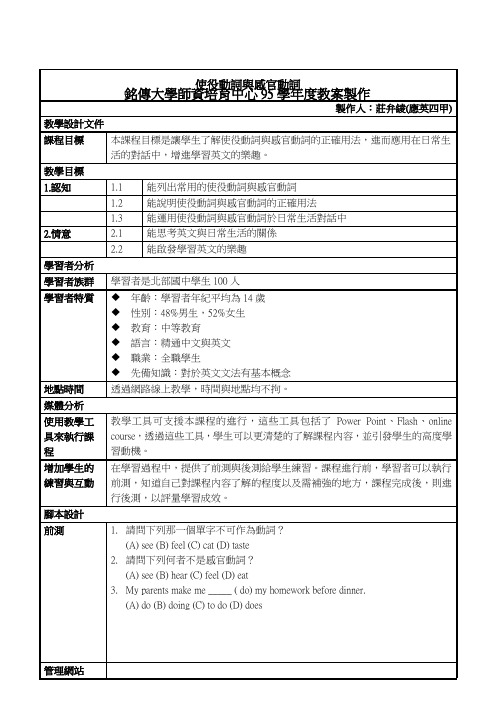
1.3 觀賞 video 1.3.1 情境對話
1.3.2 文法講解
1.3.3 小試身手
後測
請學習者在課程學習結束前,進行後測以了解自己的學習狀況
1. 請列舉常用的使役動詞與感官動詞
2. 經過課程介紹後,是否了解使役動詞與感官動詞的正確用法
3. 請用簡單的英文,利用使役動詞與感官動詞各造出一個句子
教育理論
知道使役動詞與 感官動詞的用法
具備基本的英語 對話能力
後測
請用簡單的英 文,利用使役動詞 與感官動詞造句
能簡單說明使役 動詞與感官動的 用法
請列舉常用的使 役動詞與感官動 詞
具備使役動詞與 感官動詞的概念
先備知識
使役動詞與感官動詞
銘傳大學師資培育中心 95 學年度教案製作
製作人:莊弁綾(應英四甲)
教學設計文件
課程目標
本課程目標是讓學生了解使役動詞與感官動詞的正確用法,進而應用在日常生
活的對話中,增進學習英文的樂趣。
教學目標
1.認知
1.1 能列出常用的使役動詞與感官動詞
1.2 能說明使役動詞與感官動詞的正確用法
練習與互動 前測,知道自己對課程內容了解的程度以及需補強的地方,課程完成後,則進
行後測,以評量學習成效。
腳本設計
前測
1. 請問下列那一個單字不可作為動詞?
(A) see (B) feel (C) cat (D) taste
2. 請問下列何者不是感官動詞?
(A) see (B) hear (C) feel (D) eat
1.3 能運用使役動詞與感官動詞於日常生活對話中
2.情意
2.1 能思考英文與日常生活的關係
2.2 能啟發學習英文的樂趣
感官动词的用法及口诀

感官动词的用法及口诀
感官动词see/watch/look at/hear/listen to/notice等其后可以接两种结构
do/doing sth。
感官动词和使役动词的记忆和口诀:一感二听三使四看。
1.I saw them playing football on the playground.我看到他们在操场上踢球。
感官动词表示人的感官动作,可作完全及物动词或不完全及物动词,如:listen?to(听)hear(听见)see(看见),watch(观看),feel(感觉)等。
2.感官动词作不完全及物动词时,后接宾语,再接原形不定词或分词作宾语补语。
3.感官动词的被动语态的宾语补语用不定词或现在分词。
4.感官动词表示被动含义时,不能用于进行时态;感官动词表示主动含义可以用于进行式。
hear,?see通常分别以其相应意义的介系词动词listen?to,look?at的进行式来代替。
5.当see,hear表示在一较短时间段“反覆见到、听到”的意思时,可用于进行式。
A感官动词及物动词有:
see/notice/look at/watch/observe/listen
to/hear/feelVt/tasteVt/smellVt/touchVt
B连缀动词含感官不及物动词:
be/get/become/feel/look/sound/smell/taste/seem/appear/grow/turn/prove/go/run 感谢您的阅读,祝您生活愉快。
常考动词十五类
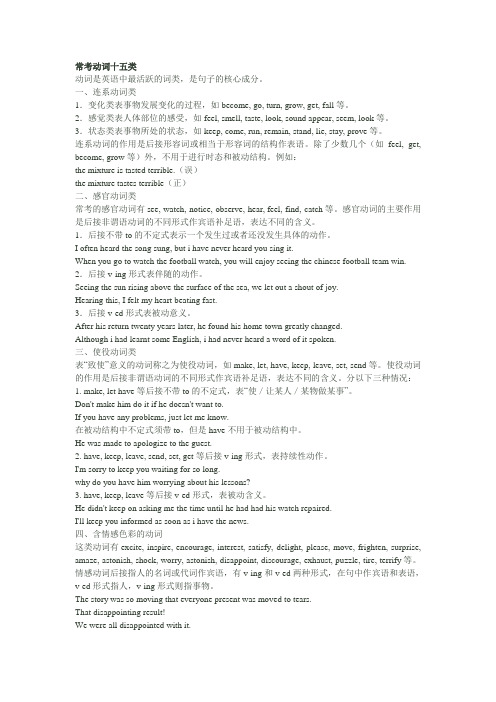
常考动词十五类动词是英语中最活跃的词类,是句子的核心成分。
一、连系动词类1.变化类表事物发展变化的过程,如become, go, turn, grow, get, fall等。
2.感觉类表人体部位的感受,如feel, smell, taste, look, sound appear, seem, look等。
3.状态类表事物所处的状态,如keep, come, run, remain, stand, lie, stay, prove等。
连系动词的作用是后接形容词或相当于形容词的结构作表语。
除了少数几个(如feel, get, become, grow等)外,不用于进行时态和被动结构。
例如:the mixture is tasted terrible.(误)the mixture tastes terrible(正)二、感官动词类常考的感官动词有see, watch, notice, observe, hear, feel, find, catch等。
感官动词的主要作用是后接非谓语动词的不同形式作宾语补足语,表达不同的含义。
1.后接不带to的不定式表示一个发生过或者还没发生具体的动作。
I often heard the song sung, but i have never heard you sing it.When you go to watch the football watch, you will enjoy seeing the chinese football team win. 2.后接v-ing形式表伴随的动作。
Seeing the sun rising above the surface of the sea, we let out a shout of joy.Hearing this, I felt my heart beating fast.3.后接v-ed形式表被动意义。
感官动词用法
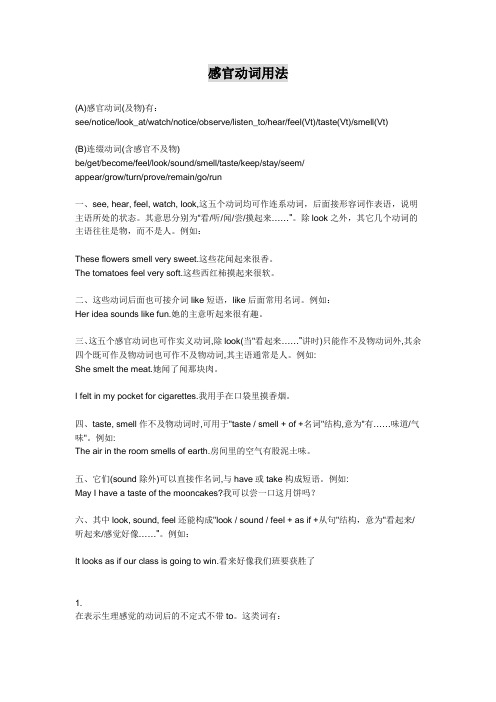
感官动词用法(A)感官动词(及物)有:see/notice/look_at/watch/notice/observe/listen_to/hear/feel(Vt)/taste(Vt)/smell(Vt)(B)连缀动词(含感官不及物)be/get/become/feel/look/sound/smell/taste/keep/stay/seem/appear/grow/turn/prove/remain/go/run一、see, hear, feel, watch, look,这五个动词均可作连系动词,后面接形容词作表语,说明主语所处的状态。
其意思分别为"看/听/闻/尝/摸起来……"。
除look之外,其它几个动词的主语往往是物,而不是人。
例如:These flowers smell very sweet.这些花闻起来很香。
The tomatoes feel very soft.这些西红柿摸起来很软。
二、这些动词后面也可接介词like短语,like后面常用名词。
例如:Her idea sounds like fun.她的主意听起来很有趣。
三、这五个感官动词也可作实义动词,除look(当"看起来……"讲时)只能作不及物动词外,其余四个既可作及物动词也可作不及物动词,其主语通常是人。
例如:She smelt the meat.她闻了闻那块肉。
I felt in my pocket for cigarettes.我用手在口袋里摸香烟。
四、taste, smell作不及物动词时,可用于"taste / smell + of +名词"结构,意为"有……味道/气味"。
例如:The air in the room smells of earth.房间里的空气有股泥土味。
五、它们(sound除外)可以直接作名词,与have或take构成短语。
常见的感官动词和使役动词

常见的感官动词和使役动词常见的感官动词和使役动词有:⼀感觉(feel)⼆听(listen to/hear)三使(let,make,have)五看(look at /see/watch/notice/observe)⼀:感官动词1)感官动词接不带to的不定式作宾语补⾜语时,强调动作的整个过程或动作经常发⽣。
I saw him steal my money.I heard her sing .I felt him touch my hand .I saw her leave.I heard him cry2)感官动词接现在分词作宾语补⾜语,强调动作正在进⾏。
I saw him stealing my money.I saw him calling .I heard her singing .I felt him touching my arm.I saw the little boy crying there.I saw her leaving.I heard him crying.3)感官动词接过去分词作宾语补⾜语,强调被动状态。
I saw him punished.I felt my hand bitten .I saw a woman robbed.I saw him taken away by police.I saw him robbed .I heard the door shut.I felt myself lifted.⼆:使役动词1)使役动词接不带to的不定式作宾语补⾜语,表⽰“让某⼈做某事”Paul’s father made him paint the house.The boss had the secretary type the letter for him.The company had him repair those failure goods.Dad got me to wash the car for him.My mother had me do the laundry for her .2)使役动词接现在分词作宾语补⾜语,表⽰“让...⼀直做某事”Our teacher made us sitting there.***Let后⾯只能接不带to的不定式作宾语补⾜语。
感官和使役动词的用法
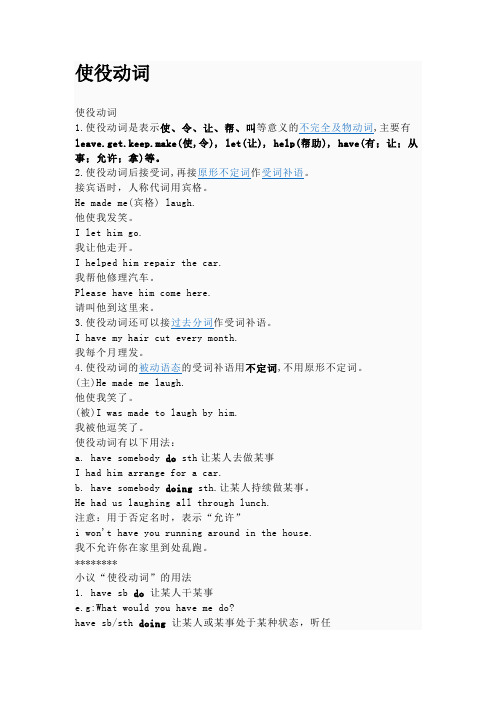
使役动词使役动词1.使役动词是表示使、令、让、帮、叫等意义的不完全及物动词,主要有leave.get.keep.make(使,令), let(让), help(帮助), have(有;让;从事;允许;拿)等。
2.使役动词后接受词,再接原形不定词作受词补语。
接宾语时,人称代词用宾格。
He made me(宾格) laugh.他使我发笑。
I let him go.我让他走开。
I helped him repair the car.我帮他修理汽车。
Please have him come here.请叫他到这里来。
3.使役动词还可以接过去分词作受词补语。
I have my hair cut every month.我每个月理发。
4.使役动词的被动语态的受词补语用不定词,不用原形不定词。
(主)He made me laugh.他使我笑了。
(被)I was made to laugh by him.我被他逗笑了。
使役动词有以下用法:a. have somebody do sth让某人去做某事I had him arrange for a car.b. have somebody doing sth.让某人持续做某事。
He had us laughing all through lunch.注意:用于否定名时,表示“允许”i won't have you running around in the house.我不允许你在家里到处乱跑。
********小议“使役动词”的用法1. have sb do让某人干某事e.g:What would you have me do?have sb/sth doing 让某人或某事处于某种状态,听任e.g: I won't have women working in our company.The two cheats had the light burning all night long.have sth done让别人干某事,遭受到e.g:you 'd better have your teeth pulled out.He had his pocket picked.notes: "done"这个动作不是主语发出来的。
“感使动词+宾语+宾语补足语”结构中“宾语补足语”的用法
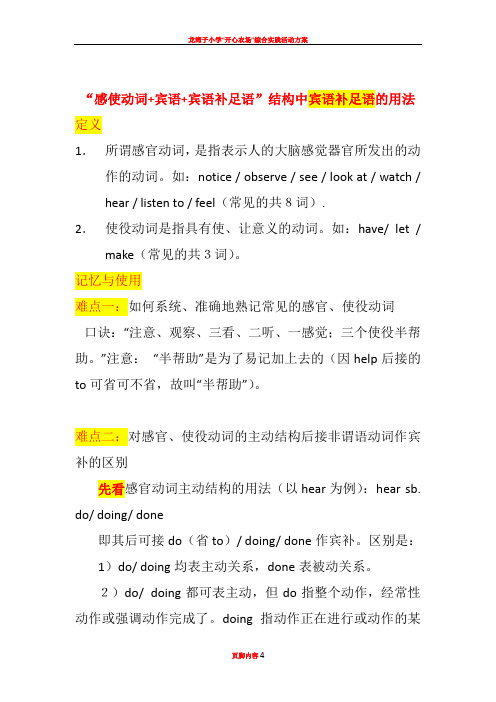
“感使动词+宾语+宾语补足语”结构中宾语补足语的用法定义1.所谓感官动词,是指表示人的大脑感觉器官所发出的动作的动词。
如:notice / observe / see / look at / watch / hear / listen to / feel(常见的共8词).2.使役动词是指具有使、让意义的动词。
如:have/ let / make(常见的共3词)。
记忆与使用难点一:如何系统、准确地熟记常见的感官、使役动词口诀:“注意、观察、三看、二听、一感觉;三个使役半帮助。
”注意:“半帮助”是为了易记加上去的(因help后接的to可省可不省,故叫“半帮助”)。
难点二:对感官、使役动词的主动结构后接非谓语动词作宾补的区别先看感官动词主动结构的用法(以hear为例):hear sb. do/ doing/ done即其后可接do(省to)/ doing/ done作宾补。
区别是:1)do/ doing均表主动关系,done表被动关系。
2)do/ doing都可表主动,但do指整个动作,经常性动作或强调动作完成了。
doing指动作正在进行或动作的某个片断。
3)done指某事由别人做(被做),也作“遭受”解。
试比较:A)I heared him sing a song. 我听他唱了一首歌(指自始至终整个过程)。
B)I heared him singing a song. 我听见他正在唱歌唱(指当时动作的某个片断)。
C)I heared a song sung.我听见(有人)唱歌(逻辑主语“歌”与“唱”是被动关系。
)再看使役动词主动结构的用法:have sb. do/ doing/ done, make/let sb. do/ donehave后也接do(省to)/ doing/ done作宾补,区别是:1)do/ doing 均表主动关系,done表被动关系。
2)do/ doing虽然都表主动,但do指目前和将来或经常性、反复性的动作。
高中英语语法:动词
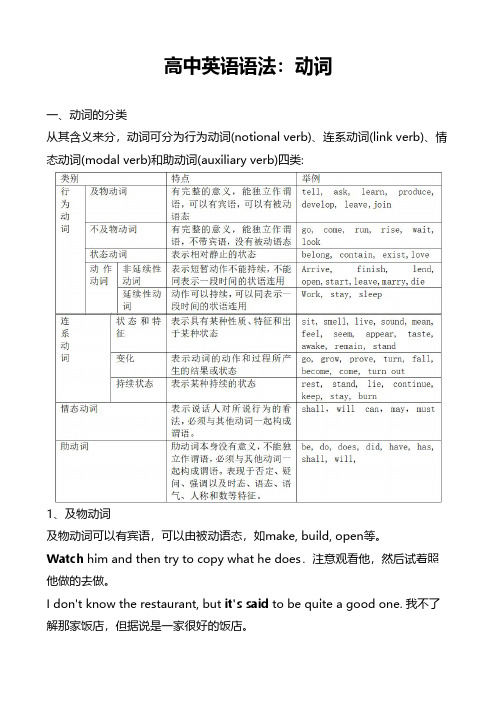
高中英语语法:动词一、动词的分类从其含义来分,动词可分为行为动词(notional verb)、连系动词(link verb)、情态动词(modal verb)和助动词(auxiliary verb)四类:1、及物动词及物动词可以有宾语,可以由被动语态,如make, build, open等。
Watch him and then try to copy what he does.注意观看他,然后试着照他做的去做。
I don't know the restaurant, but it's said to be quite a good one. 我不了解那家饭店,但据说是一家很好的饭店。
2、不及物动词She ran faster than him.她比他跑得快。
She spoke for one hour but didn't say much. “她讲了一小时,但并没说出多少(事)。
3、动作动词(1)活动动词这类动词表示各种活动,可用于进行时态,如:do, play, ask, drink, rain等。
The children were playing with a ball. 孩子们在玩球。
(2)过程动词这类动词表示情况的改变,可用于进行时态,如turn, become, grow, change 等。
Nothing will change him, and he will always be the same.什么也改变不了他,他始终是那个样子。
注意:非延续性动词不能同表示一段时间的状语连用。
He has joined the club for a long time.(误)He has been a member of the club for a long time.他加入俱乐部很长时间了。
(正)4、状态动词状态动词表示非活动性的静止状态,不用于进行时态。
但这些动词如果转义成为动态动词时可以用进行时态。
使役动词 感官动词
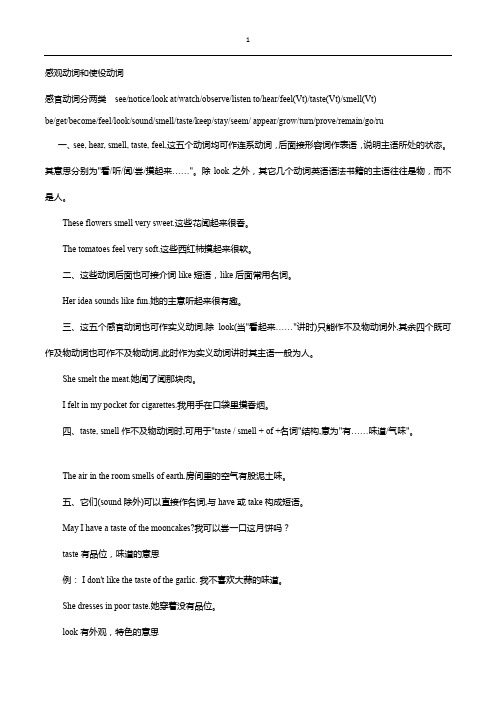
感观动词和使役动词感官动词分两类see/notice/look at/watch/observe/listen to/hear/feel(Vt)/taste(Vt)/smell(Vt)be/get/become/feel/look/sound/smell/taste/keep/stay/seem/appear/grow/turn/prove/remain/go/ru一、see,hear,smell,taste,feel,这五个动词均可作连系动词,后面接形容词作表语,说明主语所处的状态。
其意思分别为"看/听/闻/尝/摸起来……"。
除look之外,其它几个动词英语语法书籍的主语往往是物,而不是人。
These flowers smell very sweet.这些花闻起来很香。
The tomatoes feel very soft.这些西红柿摸起来很软。
二、这些动词后面也可接介词like短语,like后面常用名词。
Her idea sounds like fun.她的主意听起来很有趣。
三、这五个感官动词也可作实义动词,除look(当"看起来……"讲时)只能作不及物动词外,其余四个既可作及物动词也可作不及物动词,此时作为实义动词讲时其主语一般为人。
She smelt the meat.她闻了闻那块肉。
I felt in my pocket for cigarettes.我用手在口袋里摸香烟。
四、taste,smell作不及物动词时,可用于"taste/smell+of+名词"结构,意为"有……味道/气味"。
The air in the room smells of earth.房间里的空气有股泥土味。
五、它们(sound除外)可以直接作名词,与have或take构成短语。
May I have a taste of the mooncakes?我可以尝一口这月饼吗?taste有品位,味道的意思例:I don't like the taste of the garlic.我不喜欢大蒜的味道。
中考语法复习——感官(系)动词和使役动词测试(附解析)-最新学习文档

专题三感官系动词、感官动词及使役动词练习一、完成句子1.我能感觉到风吹着我的脸。
I could feel the wind ____________________________________.答案:blowing on my face (on +身体部位,on不能省)解析:此题中feel是感官动词,根据语境可得知感觉到的事情一定是正在发生,所以这里用的是feel sb. doing的结构。
2.我要他写一封信给我的雇主。
I got him ___________________________________ my employer.答案:to write a letter to/to write to解析:此题考察的是使役动词get的用法。
让某人做某事的结构是:get sb. to do3.那两个人让等通宵亮着。
The two men had their lights _______________________________.答案:burning all the night; burning the whole night解析:此题考察的是使役动词have的用法。
havesth.doing意为:让某事一直处于某种状态。
注意:这里的灯亮着我们用的是动词:burn。
4.老板让他们工作了一整夜。
They were made ________________ the whole night by the boss.答案:to work解析:此题考察的是使役动词make的用法。
makesb.do意思是让某人做某事;在这里是被动,所以要还原成sb. be seen to do的结构(我们把它称作省to不定式的还原)5.他的解释听起来很合理。
His explanation ________________________________________.答案:sounds reasonable解析:此题考察的是感官系动词的用法。
感官动词和使役动词语法详解-word文档

感官动词和使役动词语法详解一、感官动词1、see, hear, feel, watch, l ook, catch, notice, find, listen to, smell, seem, taste等感官动词后可接d o或d oing。
后接动词原形(do)表示动作的完整性,真实性;+d oing 表示动作的连续性,进行性。
I saw him work in the gard en yesterday.昨天我看见他在花园里干活了。
(强调“我看见了”这个事实)I saw him working in the gard en. (强调“我见他正干活”这个动作) 我看见他正在花园里干活。
★感官动词中sound, feel, l ook, smell, taste还可以做系动词,后可接形容词。
This soup tastes d elicious. The id ea sounds great.This cl oth feels soft. She l ooks beautiful in red.The fl owers smell sweet.2、使役动词使役动词是表示使、令、让、帮、叫等意义的动词,主要有make (使,令),l et (让),help (帮助),have (叫),get 等。
(1)役动词make, l et后可以接动词原形,表示让某人做某事。
He mad e me (宾格) laugh.他使我发笑。
注意:变为被动语态时,要加上to:I was mad e to laugh by him.(2)使役动词get的结构为:get +宾语+ to d o,表示让某人做某事。
例:The teacher mad e John copy the lesson ten times.= The teacher had John copy the lesson ten times.= The teacher got John to copy the lesson ten times.例:I had him mend my watch.= I got him to mend my watch.(3)help的常用结构为:help sb (to) d o sth / help sb with sth例:He helps me to study Chinese.Mary helps him with his pronunciation.(4)have做使役动词的用法1). have somebody d o sth让某人去做某事I had him arrange for a car.2). have somebody d oing sth.让某人持续做某事。
感官动词和使役动词语法详解

感官动词和使役动词语法详解一、感官动词1、see, hear, feel, watch, look, catch, notice, find, listen to, smell, se em, taste等感官动词后可接do或doing。
后接动词原形(do)表示动作的完整性,真实性;+doing 表示动作的连续性,进行性。
I saw him work in the garden yesterday.昨天我看见他在花园里干活了。
(强调“我看见了”那个事实)I saw him working in the garden. (强调“我见他正干活”那个动作)我看见他正在花园里干活。
★感官动词中sound, feel, look, smell, taste还能够做系动词,后可接形容词。
This soup tastes delicious. The idea sounds great.This cloth feels soft. She looks beautiful in red.The flowers smell sweet.2、使役动词使役动词是表示使、令、让、帮、叫等意义的动词,要紧有make (使,令),let (让),help (关心),have (叫),get 等。
(1)役动词make, let后能够接动词原形,表示让某人做某事。
He made me (宾格) laugh.他使我发笑。
注意:变为被动语态时,要加上to:I was made to laugh by him.(2)使役动词get的结构为:get +宾语+ to do,表示让某人做某事。
例:The teacher made John copy the lesson ten times.= The teacher had John copy the lesson ten times.= The teacher got John to copy the lesson ten times.例:I had him mend my watch.= I got him to mend my watch.(3)help的常用结构为:help sb (to) do sth / help sb with sth例:He helps me to study Chinese.Mary helps him with his pronunciation. (4)have做使役动词的用法1). have somebody do sth让某人去做某事I had him arrange for a car.2). have somebody doing sth.让某人连续做某事。
感官动词

(2) have+宾语+to be done have应作“有”讲,表示宾语与do是被动关系
Do you have any clothes to be washed?,Sir" asked the maid
The boss often has many letter to be typed
Which is the T-shirt that fits me most?
F 当先行词既有人,也有动物或者物体时
Can you remember the scientist and his theory that we have learned?
Have you taken down everything that Mr. Li has said?
There seems to be nothing that seems impossible for him in the world.
All that can be done has been done.
注意:
关系副词引导的定语从句都可以用“介词+关系代词”引导的定语从句来代替
Shai hai is the city where\in which I was born
I still remember the day when\on which I first came to the school
昨天我见他正在花园里干活。(强调"我见他正干活"这个动作)
The managers discussed the plan that they would like to see carried out the next year.
动词之感官动词与使役动词
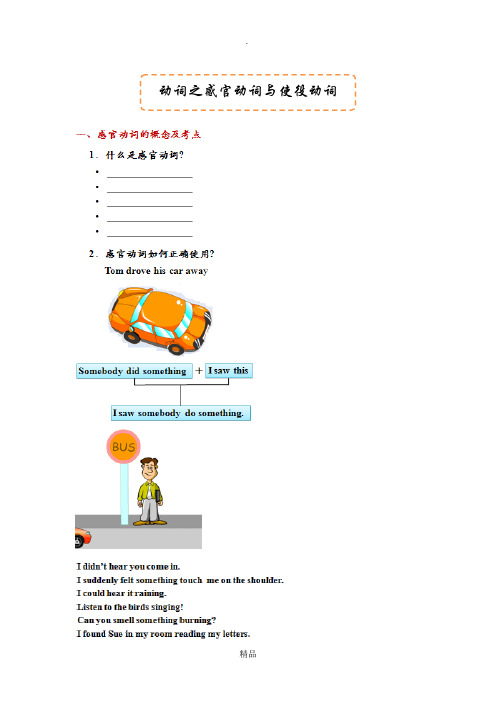
动词之感官动词与使役动词感官动词考点突破:( )1.He looked around and caught a man ______ his hand into the pocket of a passenger.A.put B.to be putting C.to put D.putting ( )2.People often see him ______ basketball on the playground.A.play B.playing C.to play D.played ( )3.The girl is heard ______ the piano in the next room on Sundays.A.plays B.to play C.played D.play ( )4.Mary was seen______ along the street when the accident happened.A.to run B.running C.run D.ran使役动词1.什么是使役动词2.使役动词的用法3.使役动词的被动语态( )1.Tom won the competition and this news made his mother ______.A.happy B.happily C.happiness D.to be happy ( )2.His mother made ______ yesterday to celebrate his birthday.A.a cake to him B.a cake himC.a cake for him D.a cake at him( )3.The boss had the workers ______ the work within two days.A.finish B.finished C.finishing D.to finish ( )4.---What are you going to do tomorrow?---I am going to have my bike ______.A.repairs B.to repair C.repaired D.repairing ( )5.The woman got her daughter ______ the clothes by herself.A.washed B.wash C.washing D.to wash总结:直击中考( )1.The heavy snow made the mountain climbers ________ on their way. (2008 北京朝阳一模)A.stop B.to stop C.stopping D.stopped( )2.---I don’t like the milk, but my mother always made me ______ it.---Your mum is right. It’s good for you. (2005北京西城一模)A.to eat B.eat C.to drink D.drink( )3.The girl was heard ______ the piano in the next room. (2007 湖南中考)A.plays B.to play C.played D.play测试题单选1.“Don’t always make Michael _______________ this or that. He is already a big boy, dear,”Mr. Bush said to his wife.A.do B.to doC.does D.did2.Mother makes me _______________ my homework every day before I can play video games.A.finish B.finishedC.finishing D.to finish3.On my way home yesterday I saw a boy ___________________.A.flies a kite B.to fly a kiteC.flying a kite D.to flying a kite4.The doss made them _______________ ten hours a day.A.to work B.workingC.worded D.work5.----- Excuse me, sir, where is Room 301?-----Just a minute, I’ll have Bob _________________ you to your room.A.show B.showsC.to show D.showing6.Betty is often seen _________________ the old man with his housework.A.help B.to helpC.helped D.helps7.----- Shopping with me?----- Sorry, I have a lot of clothes_________________.A.to wash B.washedC.wash D.to be washed8.You should und erstand the traffic rule by now. You’ve had it ________________ often enough.A.explaining B.to explainC.explain D.explained9.----- How do you feel when you see the national flag of China?----- It makes us _______________ proud.A.feel B.to feelC.felt D.feeling10.Time goes by so fast. We must never miss the chance to show love for our parents and make them ________________ how much they mean to us.A.to know B.knowingC.know D.knew答案:A A C D A B A D A C。
- 1、下载文档前请自行甄别文档内容的完整性,平台不提供额外的编辑、内容补充、找答案等附加服务。
- 2、"仅部分预览"的文档,不可在线预览部分如存在完整性等问题,可反馈申请退款(可完整预览的文档不适用该条件!)。
- 3、如文档侵犯您的权益,请联系客服反馈,我们会尽快为您处理(人工客服工作时间:9:00-18:30)。
3.使役动词的被动语态 使役动词的被动语态 ( ) 1.Tom won the competition and this news made his mother ______. A happy A. B happily B. C. happiness D. to be happy ) 2.His mother made ______ yesterday to celebrate his birthday. A a cake to him A. B a cake him B. C. a cake for him D. a cake at him
(
(
(
) 3.The boss had the workers ______ the work within two days days. A. finish B. finished C fi C. finishing i hi D t D. to fi finish ih ) 4.---What are you going to do tomorrow? ---I I am going i t to h have my bik bike ______. A. repairs B. to repair C. repaired D. repairing ) 5.The woman got her daughter ______ the clothes by herself. A. washed B. wash C. washing D. to wash
(
5
(
(
总结:直击中考 ) 1.The heavy snow made the mountain climbers ________ on their way. (2008 北京朝阳一模) A. stop B. to stop C. stopping D. stopped ) 2.---I don’t like the milk, but my mother always made me ______ it. ---Your mum is right. It’s good for you. (2005 北京西城一模) A. to eat B. eat C. to drink D. drink
Somebody did something + I saw this
I saw somebody y do something. g
I didn’t hear you come in I suddenly felt something touch me on the shoulder I could hear it raining Listen to the birds singing! Can y you smell something g burning? g I found Sue in my room reading my letters.
使役动词
1.什么是使役动词 2.使役动词的用法 ⑴make的用法 用法 make sb do sth (让某 人做某事) make sb./sth + adj (使 某人/某物….) make sb. sth = make sth th for f sb b (为某人做某物) 举例 He made his son clean the room every day. Have I made myself clear? My uncle will make me a kite = My uncle will make kite. a kite for me.
3.感官动词的被动语态 感官动词的被动语态 • I saw the girl come in. • I saw the girl dancing.
感官动词考点突破: ( ) 1.He looked around and caught a man ______ his hand into the pocket of a passenger. A put A. t B to B. t be b putting tti C. to put D. putting ( ) 2.People often see him ______ basketball on the playground. A play A. l B playing B. l i C. to play D. played
⑵have的用法 用法 举例
have sb do sth让某人去 He had his son clean the room 做某事 every day. day have sb doing sth. 让某 人持续做某事 have sth. done 某事让 别人去做 He had us laughing all through lunch lunch. He has the car washed every week.
2
感官动词考点突破: ( ) 3.The girl is heard ______ the piano in the next room on Sundays. A plays A. l B to B. t play l C. played D. play ( ) 4.Mary was seen______ along the street when the accident happened. A t A. to run B running B. i C. run D. ran
(
总结:直击中考 ) 3.The girl was heard ______ the piano in the next room. (2007 湖南中考) A. plays B. to play C. played D. play
6
3
• Jill repaired the roof. roof
Jill Wher How often I think you should I don’t like
have
+ object
+ past participle
repaired cut? cut? i t ll d installed painted serviced? cleaned taken. yesterday yesterday.
• Jill had the roof repaired.
had did you have Have you had h j has just th had d are having do you have have having
the roof your hair it central t l heating h ti the house your car that coat my photograph
1
Did anybody see the accident (happen/happening)? We listened to the old man (tell/telling) his story from beginning to end. Listen! Can you hear a baby (cry/crying)? -Why did you turn round suddenly? -I heard someone (call/calling) my name. We watched the two men (open/opening) a window and (climb/climbing) through it into the house When we got home, we found our cat (sleep/sleeping) on the table.
The roof of Jill’s house was damaged in a storm, so she arranged for somebody to repair it Y t d a workman it.Yesterday k came and d did the job. Jill had the roof repaired yesterday. This means: Jill arranged for somebody else to repair the roof . She didn’t repair it herself.
动词之感官动词与使役动词
一、感官动词的概念及考点 1.什么是感官动词 什么是感官动词? • • • • • _________________ _________________ _________________ _________________ _________________
2.感官动词如何正确使用? Tom drove his car away
i her in h h house. at the moment. soon.
想 想一想 想
4
⑶g get的用法 用法 get sb to do sth让某人 去做某事 get sb/sth. doing sth. 让 某人持续做某事;让某 物处于 种状态 物处于一种状态 get sth done让……被 做 (强调被动性动作) 举例 He got his son to clean the room every y day. y He got us laughing all through lunch. He got the car started. 他发 动了小汽车 动了小汽车。
